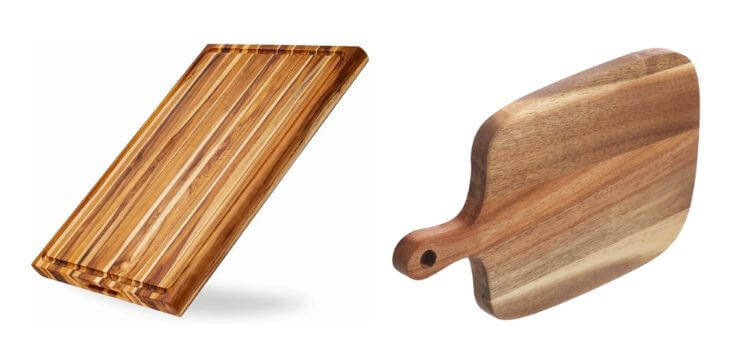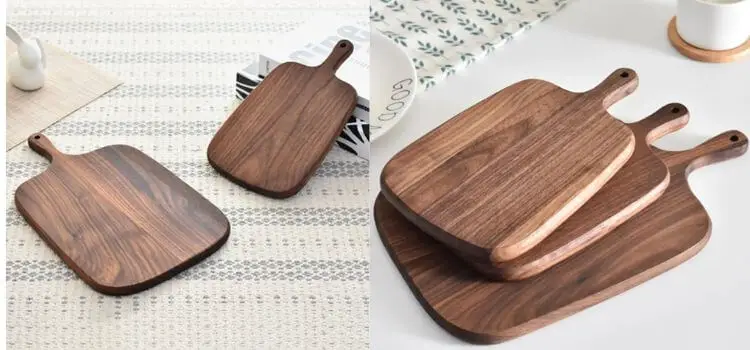As an Amazon Associate, I earn from qualifying purchases

In the bustling heart of every home—the kitchen—cutting boards play a pivotal role. They are the unsung heroes of meal preparation, the silent partners that support every chop, dice, and slice. But how many cutting boards does one really need? This question might seem trivial at first glance, yet it taps into the essence of kitchen efficiency, safety, and hygiene.
Imagine preparing a sumptuous Sunday roast. The meat is tender, the veggies fresh, and the bread perfectly baked. Yet, without the right cutting boards, this culinary symphony can quickly turn into chaos. Cutting boards are crucial in preventing cross-contamination and ensuring a smooth workflow. With the right number and type, your kitchen can transform from a mere cooking space to a well-oiled culinary machine.
Types of Cutting Boards
Understanding the array of cutting boards available is the first step toward making informed choices.
A. Wood Cutting Boards
Wooden boards are classic kitchen staples. They’re gentle on knives and provide a sturdy surface for chopping and slicing. Made from hardwoods like maple, walnut, or cherry, they’re both functional and aesthetically pleasing.
Pros:
- Durable and long-lasting if properly cared for.
- Self-healing properties that hide knife marks.
Cons:
- Require regular maintenance with mineral oil.
- Not dishwasher safe, necessitating careful handwashing.
B. Plastic Cutting Boards
Plastic boards are popular for their affordability and ease of maintenance. They come in a variety of colors, which can be handy for color-coding different food types to prevent cross-contamination.
Pros:
- Dishwasher safe.
- Lightweight and easy to store.
Cons:
- Prone to knife scars, which can harbor bacteria.
- Less durable than wood.
C. Bamboo Cutting Boards
Bamboo boards are eco-friendly options that are harder and more resistant to knife scars than traditional wood.
Pros:
- Sustainable and renewable resource.
- Lightweight and naturally antimicrobial.
Cons:
- Can be hard on knives.
- Require oiling to prevent cracking.
D. Glass and Other Materials
Glass boards are sleek and modern, often doubling as serving trays. However, they come with their own set of challenges.
Pros:
- Non-porous and easy to clean.
- Scratch-resistant surface.
Cons:
- Extremely hard on knives, dulling them quickly.
- Slippery surface can be hazardous.
Uses of Different Cutting Boards

Each type of cutting board has its preferred uses, enhancing kitchen efficiency when used correctly.
A. Meat and Poultry Preparation
Plastic boards are ideal for raw meat and poultry due to their non-porous surface and dishwasher compatibility, reducing the risk of bacterial growth.
B. Vegetables and Fruits
Wooden or bamboo boards work well for fruits and vegetables, as they provide a stable cutting surface without dulling knives too quickly.
C. Bread and Baked Goods
Breadboards, often made of wood or bamboo, are designed to handle the softer textures of bread and baked goods.
D. Specialty Boards for Specific Tasks
Consider boards with juice grooves for juicy meats or boards with measurements for precise cooking. Specialty boards can enhance your culinary experience by tailoring to specific needs.
Kitchen Hygiene and Efficiency
The importance of having multiple cutting boards cannot be overstated when it comes to hygiene. Using separate boards for raw meats, vegetables, and cooked foods minimizes cross-contamination risks. A well-organized board system can also streamline your cooking process, allowing you to switch between tasks seamlessly.
To maintain hygiene, wash boards immediately after use and sanitize them regularly. Wooden boards can be cleaned with a vinegar solution, while plastic and glass boards can be sanitized in the dishwasher.
Factors to Consider When Deciding How Many Cutting Boards to Have
Determining the right number of cutting boards depends on several personal factors.
A. Cooking Habits and Frequency
If you cook often and love experimenting with different cuisines, having multiple boards for various ingredients can simplify meal prep. Frequent chefs might need at least three to four boards to separate meats, produce, and baked goods.
B. Size and Layout of the Kitchen
In a smaller kitchen, space-saving boards like foldable or dual-purpose boards might be practical. Larger kitchens can accommodate a more extensive collection, tailored to specific tasks and aesthetic preferences.
C. Family Size and Dietary Preferences
Larger families or those with diverse dietary needs might benefit from more boards. For instance, separating boards for vegetarians and meat-eaters can help accommodate dietary restrictions.
D. Food Safety Guidelines
Adhering to food safety guidelines is crucial. The USDA recommends separate boards for raw meat and anything else to prevent cross-contamination, which can lead to foodborne illnesses.
Practical Tips for Maintaining and Storing Cutting Boards
To ensure your cutting boards last and remain safe to use, follow these maintenance tips:
A. Cleaning and Sanitizing Methods
- Wooden Boards: Hand wash with dish soap, rinse, and dry immediately. Apply mineral oil monthly to prevent drying and cracking.
- Plastic Boards: Clean with hot, soapy water or place in the dishwasher after use.
- Glass Boards: Simply wipe down or clean in the dishwasher.
B. Proper Storage Solutions
Store cutting boards vertically to prevent moisture accumulation and warping. Use a dedicated rack or storage area to keep them organized.
C. Routine Maintenance and Replacement Advice
Inspect your boards regularly for deep cuts or wear that could harbor bacteria. Replace plastic boards when knife scars become too pronounced. Wooden boards can be resurfaced periodically to extend their lifespan.
Conclusion
In conclusion, the right number of cutting boards depends on your personal culinary needs, kitchen space, and commitment to hygiene. While some home cooks might thrive with just two or three, others may find value in a more varied collection.
Evaluate your cooking habits and make informed choices that enhance both your kitchen’s efficiency and your overall cooking experience. With the right setup, you’ll not only improve your culinary artistry but also safeguard your family’s health—a win for every home chef.
FAQ
How many cutting boards are in a kitchen?
The ideal number of cutting boards in a kitchen varies based on cooking habits, but most kitchens benefit from having at least two to four boards. This allows for separate use with different food types, such as raw meats and vegetables, reducing the risk of cross-contamination.
Why do you need two cutting boards?
Having two cutting boards helps maintain food safety by separating raw meats from other ingredients like vegetables or bread. This reduces the risk of cross-contamination and ensures a more hygienic cooking environment. Different boards also allow for efficient workflow by dedicating each board to specific tasks.
How often should you get new cutting boards?
The replacement frequency for cutting boards depends on their material and condition. Wooden boards can last for years with proper care, while plastic boards should be replaced more frequently, especially when deep knife scars appear. Regularly inspect boards for wear and replace them when they become difficult to clean.
As an Amazon Associate, I earn from qualifying purchases